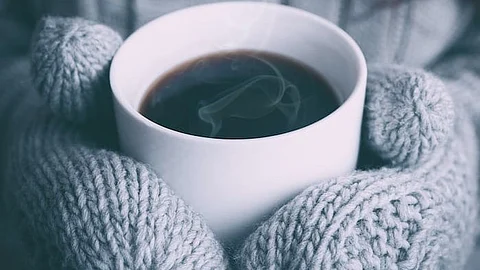

As night falls earlier and temperatures drop, it’s time to get cozy under a blanket and brew your favorite tea.
But cold weather doesn’t just bring cozy nights—extreme winter cold can damage homes, cause power outages, and threaten lives. Between 1979 and 2016, more than 19,000 Americans have died because of extreme cold. In 2021, a winter storm in Texas knocked out power for nearly 10 million people and caused the deaths of more than 200. And as climate change warms the planet, jet streams that normally lock cold air at the poles become more unstable, leading to a future where extreme winter storms may become more common.
Staying inside is the best protection against freezing temperatures, but the winter chill can still creep into houses and apartments. And if a home isn’t well-sealed and insulated against the outside air, heating bills can skyrocket during a cold snap.
At the Pacific Northwest National Laboratory (PNNL), researchers study ways that homeowners and renters can stay safe and make their homes more resilient to cold weather.
First thing’s first: “For both improving your home’s resilience against cold weather and saving on heating bills, make sure your heating system is working properly,” said Christian Kaltreider, a systems engineer at PNNL who studies energy efficiency in buildings. If the heating system is older or needs maintenance, it won’t heat as efficiently, leading to colder temperatures inside and higher heating bills. That means getting ducts checked for leaks, changing air filters, and making sure chimneys are clean for fireplaces and woodstoves.
After confirming your heating system is working correctly, start looking for places in the home where air could leak in or out, especially around windows.
According to previous research, windows generally make up 8% of a house’s exterior surface area but contribute to nearly half of the heat loss or gain through the envelope. A home can lose heat through windows in two ways: through basic conduction of heat through the glass itself, and through air leakage around the window. Triple-pane windows and windows with low-emissivity coatings increase the glass’s insulation capacity and can help reduce heat loss through conduction. If replacing windows is too costly, installing honeycomb-style shades can help lock in the heat. Studies show that honeycomb shades are 10 – 15% more effective than vinyl slat blinds at reducing heat transfer through windows.
But you don’t necessarily want to keep the shades closed all day—open shades during the sunniest part of the day to let in the sun’s natural warmth, Kaltreider said.
To address air leakage in general, make sure to check around windows, doors, and other spots in the home where air can leak in or out, such as where plumbing, ducting, or electrical wiring comes through exterior walls, floors, or ceilings. Add weather stripping or caulk to seal any holes where hot air can seep out.
One caveat to note: be wary of how much moisture you’re creating inside a well-sealed home. Activities like cooking, hanging wet clothes to dry, or using an unvented gas fireplace can increase interior moisture, said Theresa Gilbride, a building efficiency researcher at PNNL. Moisture seeping into walls, ceilings, or floors can encourage mold growth and cause wood to rot.
Preparing for a cold snap
If you know a winter storm is coming, quick fixes can keep you warm. If you can’t replace your blinds with better insulating shades, hang blankets or quilts over windows at night and then open them back up when the sun is shining.
Woodstoves and fireplaces can help add extra heat, but make sure to have chimneys cleaned regularly. Electric space heaters can also work well to provide extra warmth during a cold snap.
If you lose power and choose to use a propane space heater, portable kerosene heater, or unvented gas fireplace for heat, always make sure to crack open a window to allow fresh air in, Gilbride said. Propane space heaters emit carbon monoxide, an invisible and odorless gas that can cause headaches, nausea, and death in an improperly vented room. Make sure you have a working carbon monoxide detector if you use a propane space heater, a kerosene heater, or an unvented gas fireplace.
Big renovations
"One of the biggest ways to make your home resilient to cold temperatures is just air-sealing and insulating your attic," said Gilbride. This could include hiring a contractor to caulk and spray foam in the spaces where pipes, ducts, wiring, or recessed can lights come through walls or ceilings, as well as adding insulation. If your heating system’s ducts are in the attic, a contractor can test those for air tightness and adequate insulation levels as well.
Insulating attic space can also decrease risk of an ice dam developing on the roof, Gilbride said. Ice dams form when snow and ice pile up and then warm air leaks from the roof. That heat will melt the underside of the block of snow, which then slides down the roof and re-freezes, building a “dam” at the edge at the roof. Dripping water can then seep under shingles and back into the home.
When re-siding, consider adding rigid foam insulation to the exterior of the walls before you install the new siding, which will help trap warm air inside and keep cold air out.
Landscaping can also provide cold weather benefits.
Learn more
To learn more, PNNL offers detailed how-to guides to help prepare a home for winter weather. These guides can be found under the topic “Winter Weather” in the Disaster Resistance section of the Building America Solution Center:
Winter Weather Overview Guide
Managing Indoor Humidity and Ventilation in Cold Weather
Insulating Plumbing Pipes
Fireplaces and Wood Stoves Have Proper Ventilation
Attic Air Sealing, Insulating, and Ventilating for Ice Dam Prevention
The Building America Solution Center is sponsored by the Department of Energy’s Office of Energy Efficiency and Renewable Energy under the Building Technologies Office. (VP/Newswise)
